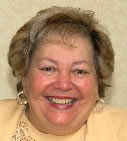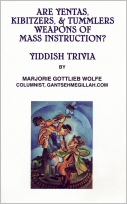  
|
  
|
GIVE A "GESHRAI"--A SHOUT:
MAHJONGG GAME CAN CAUSE EPILEPSY

True or False?
1. In every Jewish home there's someone
who has an innate sense of how long to
cook the holiday brisket. T F
2. Traditional Jewish homes have a pushke,
a small box/container with a coin slot
used to collect money for a charitable
organization. T F
3. In every Jewish home there's a sign
which reads: THE BEST MEDICINE IS
CHICKEN SOUP. T F
4. In every Jewish home there's one
10 year-old who can program the
iPod. T F
5. In every Jewish home we can find at
least one MahJongg set. T F
6. U. S. Rep., Robert Wexler, said that
Barach Obama would try to convert
[Jewish] voters one Mah-Jongg table
at a time... T F
7. There's a legend that Noah played
MahJongg on his ark during the Biblical
flood. T F
All of the above statements are true!
MahJongg is a game that has been
played in China since about 500 B.C. It
is now played in many parts of the world.
The game has become as much a part of
Jewish life as Chinese food.
Polina Olsen ("The Jewish Review, 9/25/08), says, "The
Chinese took 1,000
years to develop one way to play MahJongg: the Jews took one year to
develop 1,000 ways."
How do you account for the popularity
of MahJongg? Perhaps the close proximity
of tenement life--the way most women were home during the day--the passage
of
tradition from mother to "tuchter" (daughter), is one possible explanation.
The game has gotten many women through
tough times. This comaraderie is documented in the video, "Mah-Jongg--The
Tiles That Bind." The video focuses on
both Asian- and Jewish-American women
who play the game.
"Mah-jongg helped us get through bad
times, through the Depression, through
times without jobs, through illness, through
loss of a loved one, and that was very
important," says some avid players on the
video.
Linda Kline, MahJongg player, says that she
came home from school every day to her
mother's clicking tiles and swore she'd never play the game. "Now I really
like it," she says. "It's reminiscent of our youth, watching our mothers
play, but it's also a common ground for women to get together."
For those unfamiliar ith the game, the
basic tiles contain three suits--dots
("pintlekh" in Yiddish), bams ("bambu") and
cracks/craks ("shpaltn"). The other tiles
are dragons ("drakonen"), winds, flowers
("blimen") and jokers "zhokers").
By picking and discarding, you make specific
combinations, which correspond to certain
hands. The hands are printed on a card
every player must own. Each year a new
card is sold that shows the year, and
different game (hands) are on those cards.
This makes it more interesting.
Varda Grinspan ("Der Bay", The
International Anglo-Yiddish Newspaper,
Dec. 2007) provides some useful MahJongg
expressions in Yiddish:
"Lomir shpiln" Let's
play
"Nem a kakhl" Take
a tile
"Varf avek" Discard
"Tsumish di kakhlen" Mix the tiles
"Makh a vant" Make
a wall
American MahJongg is considered a Jewish
game, as many American MahJongg players
are of Jewish descent, and the NMJL was
founded by Jewish players; it's considered
a Jewish organization.
The Sun-Sentinel (Dec. 26, 2003) says that
Mah-Jongg is played in retirement
communities across Florida. Game experts
say the game has increased in popularity
among men.
Yes, the game is no longer relegated to
Hadassah/Sisterhood/Brandeis gatherings
and bubbe's "voyntsimer"(living room). It's
no longer an "old-lady's game."
Elaine Sandberg of Los Angeles, is a
MahJongg instructor and has taught the
game for Holland American Cruise Lines and at American Jewish University. She
is
hoping to help MahJongg crack age and
racial barriers.
Perhaps you remember Eddie Cantor's
singing the song, "Since Ma is Playing
Mah Jong." The decorative cover features
a picture of Cantor, one of the most popular entertainers of the time. The
song
was about a non-Chinese family that's
corrupted by Mah Jong; it turns the wife
into a Chinese and she wears a kimono--which is not Chinese--plays mah jongg,
starts cooking Chinese food and it drives
the husband so crazy that he wants to kill
"chinks." Yes, this was ugly racism at its
worst.
So, now for the "shlecht" (bad) news:
A study by doctgors in Hong Kong has
concluded that epilepsy can be induced
by the Chinese tile game of mahjong. The
findings were based on 23 cases of people
who had suffered mahjong-induced seizures.
The study led the doctors to define mahjong epilepsy as a unique syndrome.
Epileptic seizures can be provoked by a wide variety of triggers, but one cause
increasingly evident to researchers is the
playing--or even watching--of mahjong.
The doctors concluded that the syndrome
affects far more men than women; that
their average age is 54; and that it can hit
sufferers anywhere between one to 11
hours into a mahjong game. They say the attacks were not just caused
by sleep
deprivation or gambling stress
Mahjong is cognitively demanding,
drawing on memory, fast calculations,
concentration, reasoning and sequencing.
The distinctive design of mahjong tiles,
and the sound of the tiles crashing onto the
table, may contribute to the syndrome.
So, what's the bottom line? The only sure
way to avoid mahjong epilepsy, is to avoid
mahjong, which for many people is easier
said than done.
"Me zol nit visn fun azoyne tsores."
(We shouldn't know about such troubles.)
___________________________
| A | B | C | D | E | F | G | H | I | J | K | L | M |
| N | O | P | Q | R | S | T | U | V | W | Y | Z |


| Yiddish
Stuff Jewish Humor Schmooze News More Majorie Wolfe |
Principle Jewish Stories All Things Jewish Jewish Communities of the World |